Hawzah News Agency – At a time when Catholicism in Australia faces crises such as a loss of faith and declining religious practice, a plenary council preparatory document shows “serious failures” that suggest a lack of confidence and “evangelical vigor,” one archbishop has said.
The document’s doctrinal contradictions and general tone, he said, can encourage Catholics to shrink from their “prophetic task” and become caught in a “spiritual paralysis.”
“This is the time for the Church to rise up with new evangelical vigor. This is the time to turn all our attention to announcing a word of life and hope,” Archbishop Julian Porteous of Hobart said in an April 11 commentary. In reading the working document, he said, “I sense a church that has lost confidence in itself; a church that has lost confidence in its identity and mission.”
“The sharp edge of the call to conversion and faith is lacking in the document. In the face of the rise of those who declare that they have no faith it is necessary more than ever to issue the call to faith,” said Porteous, whose archdiocese is on the island of Tasmania.
“The Church in Australia is in the midst of an existential crisis as it witnesses thousands abandoning participation in the sacramental life of the Church each year,” he added. “The Church is in serious decline, yet no real recognition of this reality is given in the document.”
“Because the crisis of faith is not acknowledged, the document makes no effort to propose a way forward for the Church,” he said.
Porteous wrote in response to the working document “Towards the Second Assembly,” assembled as the Catholic Church in Australia is in the midst of its Fifth Plenary Council. A plenary council is the highest formal gathering of all particular Churches in a country, and it has legislative and governing authority. The first assembly of the plenary council took place in October 2021 in Adelaide. The second assembly is set to be held July 4-9 in Sydney.
Laypeople have been invited to participate in council sessions and bishops will vote on binding resolutions, which will be sent to the Vatican for approval.
The working document, which has not been released to the public, includes draft proposals that will be up for a vote at the next assembly. According to the Archdiocese of Sydney-based newspaper The Catholic Weekly, these propositions include “every dimension of Church life from governance to liturgical worship and vary in character from radical reforms to conservative defenses of traditional practices.”
Porteous, however, thought that the working document should not set the agenda for the next meeting.
“If this working document is largely accepted as the basis for the Second Assembly it will not facilitate the spiritual and pastoral renewal so needed at this time, but rather it will allow the process of further decline to occur, if not accelerate it,” he said. “Without a serious effort at interior renewal and a new zeal for evangelization the Church in Australia runs the risk of becoming a shallow image of its former self.”
“One senses in this document a church that has become tired and has lost its sense of purpose; a church that has surrendered to the surrounding cultural ethos,” he added. The document too rarely speaks of “bringing people under the grace of salvation by a bold proclamation of the cross of Christ.”
About 1 in 10 Catholics in Australia regularly attend Mass, and Church leaders have voiced concern about vocations to the priesthood, religious life, and marriage. In addition to a culture of secularism, the Church continues to respond to sexual abuse scandals. A 2017 royal commission report found that the Catholic Church and other institutions in the country showed serious failings for decades in protecting children from abuse.
Rather than seeing “more effective ways to communicate the Gospel to the age,” Porteous said, the document is more about “adapting to the times rather than finding new ways to evangelize the times.”
“The true ‘sign of our times’ is that our society has lost sight of Christ, lost a desire for truth as it embraces all sorts of ideologies, and no longer knows that there is a loving and merciful God who has created the universe and desires that all come to salvation and know the truth,” he said.
“What is lacking is the nobility of vision found in the great works of the Catholic intellectual tradition,” the archbishop continued. “The text is like a modern office block in comparison to a cathedral: functional but lacking that which elevates the mind and heart and witnesses to the transcendent.”
The archbishop also warned that the document embraces “a number of proposals that are inconsistent with authentic Catholic faith and would simply hasten the demise of the faith in Australia.”
He criticized the document’s attempt to revive general absolution as a replacement for sacramental confession. At one point the document goes “directly against Catholic teaching” by asking bishops to “continue to review the universal teaching of the Church which precludes women from the papacy, the episcopacy and priesthood.” In the archbishop’s view, it lacks efforts to promote the “authentic religious life” of women religious, and instead promotes the ordination of women as deacons.
Rather than discuss a positive role for priests, including “clear and unambiguous promotion” of priestly vocations, the document instead calls for changes to Catholic teaching and practice by proposing that lay people be allowed to preach at Mass.
“The desire for the clericalization of the laity reflects a confusion about the complementary roles of priest and laity in the sacred liturgy and more generally in the mission of the Church,” Porteous said.
The document’s intentions to promote lay involvement and the involvement of women have merit, but its specific proposals go awry, he said. Porteous questioned the document’s proposal of a lay body to parallel the Australian Catholic Bishops Conference. Many proposals on this question “clearly go against the consistent teaching of the Church, expressed most recently in the teachings of the Second Vatican Council, that such governance by divine intent, is solely entrusted to bishops.”
“The language used in the document at times is more akin to that of a secular report than of an ecclesial document,” he added. In his view, it too often presents the Church “on the horizontal level as simply a friendly community.” He cited descriptions of the Church as “supportive and inclusive community” or “a just, compassionate and outward looking Church.”
“While we hope this is true, there is no real witness in the document to its deeper reality as, for example, the ‘Mystical Body of Christ’. The mystery of the Church is not in evidence,” said the archbishop.
“The document mouths the aspirations of the times giving them a Christian veneer. It uncritically adopts the language of the day, like its repeated declaration that we are ‘an inclusive Church’,” he lamented.
For Porteous, Catholics need to take the path of “entering more deeply into the mystery of the Church to unleash the power of the life of grace.”
He called for the Catholic Church to be prepared “to be a prophetic voice speaking truth with love within the culture, to challenge the prevailing ethos.”
“Have we become afraid to speak out what we believe?” he asked. “If we shrink from our prophetic task we will become caught in a spiritual paralysis.”



Your Comment